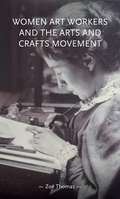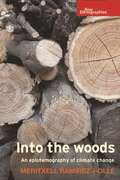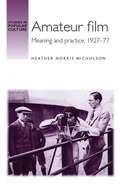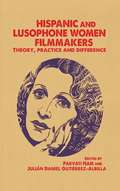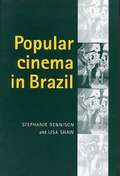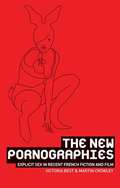- Table View
- List View
Remaking the urban: Heritage and transformation in Nelson Mandela Bay (Manchester University Press)
by Naomi RouxAfter the end of the apartheid regime in the 1990s, South Africa experienced a boom in new heritage and commemorative projects. These ranged from huge new museums and monuments to small community museums and grassroots memory work. At the same time, South African cities have continued to grapple with the difficulties of overcoming entrenched inequalities and divisions. Urban spaces are deep repositories of memory, and also sites in need of radical transformation. Remaking the Urban examines the intersections between post-apartheid urban transformation and the politics of heritage-making in divided cities, using the Nelson Mandela Bay Metro in South Africa’s Eastern Cape as a case study. Roux unpacks the processes by which some narratives and histories become officially inscribed in public space, while others are visible only through alternative, ephemeral or subversive means. Including discussions of the history of the Red Location Museum of Struggle; memorialisation of urban forced removals; the heritage politics and transformative potential of public art; and strategies for making visible memories and histories of former anti-apartheid youth activist groups in the city’s townships, Roux examines how these twin processes of memory-making and change have played out in Nelson Mandela Bay.
Descending with angels: Islamic exorcism and psychiatry: a film monograph (Anthropology, Creative Practice and Ethnography)
by Christian SuhrOver several years, Christian Suhr followed Muslim patients being treated for jinn possession and psychosis in a Danish mosque and in a psychiatric hospital. Through rich filmic and textual case studies, he shows how the bodies and souls of Muslim patients become a battlefield between the moral demands of Islam and the psychiatric institutions of European nation-states. The book reveals how both psychiatric and Islamic healing work to produce relief from pain, and also entail an ethical transformation of the patient and the cultivation of religious and secular values through the experience of pain. Creatively exploring the analytic possibilities provided by the use of a camera, both text and film show how disruptive ritual techniques are used in healing to destabilise individual perceptions and experiences of agency, which allows patients to submit to the invisible powers of psychotropic medicine or God.
Descending with angels: Islamic exorcism and psychiatry: a film monograph (Anthropology, Creative Practice and Ethnography)
by Christian SuhrOver several years, Christian Suhr followed Muslim patients being treated for jinn possession and psychosis in a Danish mosque and in a psychiatric hospital. Through rich filmic and textual case studies, he shows how the bodies and souls of Muslim patients become a battlefield between the moral demands of Islam and the psychiatric institutions of European nation-states. The book reveals how both psychiatric and Islamic healing work to produce relief from pain, and also entail an ethical transformation of the patient and the cultivation of religious and secular values through the experience of pain. Creatively exploring the analytic possibilities provided by the use of a camera, both text and film show how disruptive ritual techniques are used in healing to destabilise individual perceptions and experiences of agency, which allows patients to submit to the invisible powers of psychotropic medicine or God.
Women art workers and the Arts and Crafts movement (Gender in History)
by Zoë ThomasThis book constitutes the first comprehensive history of the network of women who worked at the heart of the English Arts and Crafts movement from the 1870s to the 1930s. Challenging the long-standing assumption that the Arts and Crafts simply revolved around celebrated male designers like William Morris, it instead offers a new social and cultural account of the movement, which simultaneously reveals the breadth of the imprint of women art workers upon the making of modern society. Thomas provides unprecedented insight into how women navigated authoritative roles as 'art workers' by asserting expertise across a range of interconnected cultures: from the artistic to the professional, intellectual, entrepreneurial and domestic. Through examination of newly discovered institutional archives and private papers, Thomas elucidates the critical importance of the spaces around which women conceptualised alternative creative and professional lifestyles.
Women art workers and the Arts and Crafts movement (Gender in History)
by Zoë ThomasThis book constitutes the first comprehensive history of the network of women who worked at the heart of the English Arts and Crafts movement from the 1870s to the 1930s. Challenging the long-standing assumption that the Arts and Crafts simply revolved around celebrated male designers like William Morris, it instead offers a new social and cultural account of the movement, which simultaneously reveals the breadth of the imprint of women art workers upon the making of modern society. Thomas provides unprecedented insight into how women navigated authoritative roles as 'art workers' by asserting expertise across a range of interconnected cultures: from the artistic to the professional, intellectual, entrepreneurial and domestic. Through examination of newly discovered institutional archives and private papers, Thomas elucidates the critical importance of the spaces around which women conceptualised alternative creative and professional lifestyles.
Voices from the Underworld: Chinese Hell deity worship in contemporary Singapore and Malaysia (Alternative Sinology)
by Fabian GrahamIn Singapore and Malaysia, the inversion of Chinese Underworld traditions has meant that Underworld demons are now amongst the most commonly venerated deities in statue form, channelled through their spirit mediums, tang-ki. The Chinese Underworld and its sub-hells are populated by a bureaucracy drawn from the Buddhist, Taoist and vernacular pantheons. Under the watchful eye of Hell’s ‘enforcers’, the lower echelons of demon soldiers impose post-mortal punishments on the souls of the recently deceased for moral transgressions committed during their prior incarnations. Voices from the Underworld offers an ethnography of contemporary Chinese Underworld traditions, where night-time cemetery rituals assist the souls of the dead, exorcised spirits are imprisoned in Guinness bottles, and malicious foetus ghosts are enlisted to strengthen a temple’s spirit army. Understanding the religious divergences between Singapore and Malaysia through an analysis of socio-political and historical events, Fabian Graham challenges common assumptions on the nature and scope of Chinese vernacular religious beliefs and practices. Graham’s innovative approach to alterity allows the reader to listen to first-person dialogues between the author and channelled Underworld deities. Through its alternative methodological and narrative stance, the book intervenes in debates on the interrelation between sociocultural and spiritual worlds, and promotes the de-stigmatisation of spirit possession and discarnate phenomena in the future study of mystical and religious traditions.
Voices from the Underworld: Chinese hell deity worship in contemporary Singapore and Malaysia (Alternative Sinology)
by Fabian GrahamVoices from the Underworld focuses on Singapore and Malaysia’s contemporary Chinese Underworld traditions where Hell deities are now amongst the most commonly venerated deities on altars and when channelled through spirit mediums. Intended for academics, lecturers, students, and those intrigued with Chinese culture, while highlighting the Taoist and Buddhist cosmologies upon which present-day beliefs and practices are based, the ethnography provides readers with unique insights into the lived tradition.Embracing ontological and dialogic approaches to religious phenomena, alterity is taken seriously, and practitioner’s beliefs interpreted without bias. The emic voice is literally heard through first-person dialogues between the author and channelled Underworld deities throughout the ethnography. This alternative approach challenges wider present-day discourse concerning the interrelationships between sociocultural and spiritual worlds.
Border porosities: Movements of people, objects, and ideas in the southern Balkans (Rethinking Borders)
by Rozita DimovaThis innovative book documents border porosities that have developed and persisted between Greece and North Macedonia over different temporalities and at different localities. By drawing on geology’s approaches to studying porosity, Dimova argues that similar to rocks and minerals that only appear solid and impermeable, seemingly impenetrable borders are inevitably traversed by different forms of passage.The rich ethnographic case studies, from the history of railroads in the southern Balkans, border town beauty tourism, child refugees during the Greek Civil War, mining and environmental activism, and the urban renovation project in Skopje, show that the political borders between states do not only restrict or regulate the movement of people and things, but are also always permeable in ways that exceed state governmentality.
Border porosities: Movements of people, objects, and ideas in the southern Balkans (Rethinking Borders)
by Rozita DimovaThis innovative book documents border porosities that have developed and persisted between Greece and North Macedonia over different temporalities and at different localities. By drawing on geology’s approaches to studying porosity, Dimova argues that similar to rocks and minerals that only appear solid and impermeable, seemingly impenetrable borders are inevitably traversed by different forms of passage.The rich ethnographic case studies, from the history of railroads in the southern Balkans, border town beauty tourism, child refugees during the Greek Civil War, mining and environmental activism, and the urban renovation project in Skopje, show that the political borders between states do not only restrict or regulate the movement of people and things, but are also always permeable in ways that exceed state governmentality.
Germs and governance: The past, present and future of hospital infection, prevention and control (Social Histories of Medicine #27)
by David CantorGerms and governance brings together leading historians, practitioners and policy makers to consider the past, present and future of hospital infection control. Combining historical case-studies with practitioner experiences, this volume offers a new understanding of the emergence of theories of germ transmission and containment and how these theories played out in real-world environments, networks and professional organisations. Exploring the historical context in which technologies like gloves were developed and popularised, as well as how relationships between communities and hospitals, doctors and nurses, and the emerging role of hospital bacteriologists have shaped infection control practices, the collection emphasises the diverse contexts in which ideas about germs, infection and safety circulated. The volume also addresses the historical neglect of the critical role of nurses in the development and success of infection control measures.
Germs and governance: The past, present and future of hospital infection, prevention and control (Social Histories of Medicine #27)
by David CantorGerms and governance brings together leading historians, practitioners and policy makers to consider the past, present and future of hospital infection control. Combining historical case-studies with practitioner experiences, this volume offers a new understanding of the emergence of theories of germ transmission and containment and how these theories played out in real-world environments, networks and professional organisations. Exploring the historical context in which technologies like gloves were developed and popularised, as well as how relationships between communities and hospitals, doctors and nurses, and the emerging role of hospital bacteriologists have shaped infection control practices, the collection emphasises the diverse contexts in which ideas about germs, infection and safety circulated. The volume also addresses the historical neglect of the critical role of nurses in the development and success of infection control measures.
Frantz Fanon, postcolonialism and the ethics of difference (The A to Z Guide Series, No. 194)
by Azzedine HaddourFanon, postcolonialism and the ethics of difference underscores the ethical dimension of Fanon’s work by focusing on the interplay of language, gender and colonial politics, by discussing the implication of the medical and psychiatric establishment in the institution of colonialism and by assessing the importance of existential phenomenology in Fanon’s project of decolonisation.
Frantz Fanon, postcolonialism and the ethics of difference (The A to Z Guide Series, No. 194)
by Azzedine HaddourFanon, postcolonialism and the ethics of difference underscores the ethical dimension of Fanon’s work by focusing on the interplay of language, gender and colonial politics, by discussing the implication of the medical and psychiatric establishment in the institution of colonialism and by assessing the importance of existential phenomenology in Fanon’s project of decolonisation.
Immigrants as outsiders in the two Irelands
by Bryan Fanning Lucy MichaelImmigrants as outsiders in the two Irelands examines how a wide range of immigrant groups who settled in the Republic of Ireland and in Northern Ireland since the 1990s are faring today. It asks to what extent might different immigrant communities be understood as outsiders in both jurisdictions. Chapters include analyses of the specific experiences of Polish, Filipino, Muslim, African, Roma, refugee and asylum seeker populations and of the experiences of children, as well as analyses of the impacts of education, health, employment, housing, immigration law, asylum policy, the media and the contemporary politics of borders and migration on successful integration. The book is aimed at general readers interested in understanding immigration and social change and at students in areas including sociology, social policy, human geography, politics, law and psychology.
Immigrants as outsiders in the two Irelands
by Bryan Fanning Lucy MichaelImmigrants as outsiders in the two Irelands examines how a wide range of immigrant groups who settled in the Republic of Ireland and in Northern Ireland since the 1990s are faring today. It asks to what extent might different immigrant communities be understood as outsiders in both jurisdictions. Chapters include analyses of the specific experiences of Polish, Filipino, Muslim, African, Roma, refugee and asylum seeker populations and of the experiences of children, as well as analyses of the impacts of education, health, employment, housing, immigration law, asylum policy, the media and the contemporary politics of borders and migration on successful integration. The book is aimed at general readers interested in understanding immigration and social change and at students in areas including sociology, social policy, human geography, politics, law and psychology.
Higher education in a globalising world: Community engagement and lifelong learning (Universities and Lifelong Learning)
by Peter MayoThis book focuses on current policy discourse in Higher Education, with special reference to Europe. It discusses globalisation, Lifelong Learning, the EU’s Higher Education discourse, this discourse’s regional ramifications and alternative practices in Higher Education from both the minority and majority worlds with their different learning traditions and epistemologies. It argues that these alternative practices could well provide the germs for the shape of a public good oriented Higher Education for the future. It theoretically expounds on important elements to consider when engaging Higher Education and communities, discussing the nature of the term ‘community’ itself. Special reference is accorded to the difference that lies at the core of these ever-changing communities. It then provides an analysis of an ‘on the ground project’ in University community engagement, before suggesting signposts for further action at the level of policy and provision.
Higher education in a globalising world: Community engagement and lifelong learning (Universities and Lifelong Learning)
by Peter MayoThis book focuses on current policy discourse in Higher Education, with special reference to Europe. It discusses globalisation, Lifelong Learning, the EU’s Higher Education discourse, this discourse’s regional ramifications and alternative practices in Higher Education from both the minority and majority worlds with their different learning traditions and epistemologies. It argues that these alternative practices could well provide the germs for the shape of a public good oriented Higher Education for the future. It theoretically expounds on important elements to consider when engaging Higher Education and communities, discussing the nature of the term ‘community’ itself. Special reference is accorded to the difference that lies at the core of these ever-changing communities. It then provides an analysis of an ‘on the ground project’ in University community engagement, before suggesting signposts for further action at the level of policy and provision.
Into the woods: An epistemography of climate change (New Ethnographies)
by Meritxell Ramírez-i-OlléThis book is a detailed exploration of the working practices of a community of scientists exposed in public, and of the making of scientific knowledge about climate change in Scotland. For four years, the author joined these scientists in their sampling expeditions into the Caledonian forests, observed their efforts in the laboratory to produce data from wood samples and followed their discussions of a graph showing the evolution of the Scottish temperature over the past millennium in conferences, workshops and peer-review journals. This epistemography of climate change is of broad social and academic relevance – both for its contextualised treatment of a key contemporary science, and for its original formulation of a methodology for investigating expertise.
Into the woods: An epistemography of climate change (New Ethnographies)
by Meritxell Ramírez-i-OlléThis book is a detailed exploration of the working practices of a community of scientists exposed in public, and of the making of scientific knowledge about climate change in Scotland. For four years, the author joined these scientists in their sampling expeditions into the Caledonian forests, observed their efforts in the laboratory to produce data from wood samples and followed their discussions of a graph showing the evolution of the Scottish temperature over the past millennium in conferences, workshops and peer-review journals. This epistemography of climate change is of broad social and academic relevance – both for its contextualised treatment of a key contemporary science, and for its original formulation of a methodology for investigating expertise.
Amateur film: Meaning and practice c. 1927–77 (Studies in Popular Culture)
by Heather NicholsonAmateur film: Meaning and practice 1927–77 plunges readers into the world of home movies making and reveals that behind popular perceptions of clichéd family scenes shakily shot at home or by the sea, there is much more to discover. Exploring who, how, where, when and why amateur enthusiasts made and shared their films provides fascinating insights into an often misunderstood aspect of national visual history. This study of how non-professional filmmakers responded to the new possibilities of moving image places decades of cine use into a history of changing visual technologies that span from Edwardian visual toys to mobile phones. Using northern cine club records, interviews and amateur films, the author reveals how film-making practices ranged from family footage to highly crafted edited productions about local life and distant places made by enthusiasts who sought to ‘educate, inspire and entertain’ armchair audiences during the early decades of British television.
Hispanic and Lusophone women filmmakers: Theory, practice and difference
by Parvati Nair Julian Gutierrez-AlbillaThis volume examines the films of Hispanic and Lusophone women filmmakers from the 1930s to the present day. It establishes productive connections between film practices across these geographical areas by identifying common areas of concern on the part of these female filmmakers. Focusing on aesthetic, theoretical and socio-historical analyses, it questions the manifest or latent gender and sexual politics that inform and structure the emerging cinematic productions by women filmmakers in Portugal, Spain, Latin America and the US. With a combination of scholars from the UK, the US, Spain and Latin America, the volume documents and interprets a fascinating corpus of films made by Hispanic and Lusophone women and proposes research strategies and methodologies that can expand our understanding of socio-cultural and psychic constructions of gender and sexual politics. An essential resource to rethink notions of gender identity and subjectivity, it is a unique contribution to Spanish and Latin American Film Studies and Film Studies.
Popular cinema in Brazil, 1930–2001
by Stephanie Dennison Lisa ShawBrazil has one of the most significant and productive film industries in Latin America. This ground-breaking study provides an entertaining insight into the Brazilian films that have most captured the imagination of domestic audiences over the years. The recent international success of films such as Central Station and City of God, has stimulated widespread interest in Brazilian film, but studies written in English focus on the 'auteur' cinema of the 1960s. This book focuses on individual films in their socio-historical context, drawing on extensive fieldwork in Brazil and Latin America. It argues that Brazilian cinema has almost always been grounded in intrinsically home-grown cultural forms, dating back to the nineteenth century, such as the Brazilian music-hall, the travelling circus, radio shows, carnival, and, later, comedy television. Combining a chronological structure with groundbreaking research and a lively approach, Popular cinema in Brazil is the ideal introduction to Brazilian cinema.
The British working class in postwar film
by Philip GillettAn incidental pleasure of watching a film is what it tells us about the society in which it is made. Using a sociological model, The British working class in postwar film looks at how working-class people were portrayed in British feature films in the decade after the Second World War. Though some of the films examined are well known, others have been forgotten and deserve reassessment. Original statistical data is used to assess the popularity of the films with audiences. With its interdisciplinary approach and the avoidance of jargon, this book seeks to broaden the approach to film studies. Students of media and cultural studies are introduced to the skills of other disciplines, while sociologists and historians are encouraged to consider the value of film evidence in their own fields. This work should appeal to all readers interested in social history and in how cinema and society works.
The new pornographies: Explicit sex in recent French fiction and film
by Martin Crowley Victoria BestThe turn of the twenty-first century has witnessed the striking advance of pornography into the Western cultural mainstream. Symptomatic of this development has been the use by writers, artists, and film-makers of the imagery and aesthetics of pornography, in works which have, often on this basis, achieved considerable international success. Amongst these artists are a number of French authors and directors - such as Michel Houellebecq, Catherine Breillat, Virginie Despentes, or Catherine Millet - whose work has often been dismissed as trashy or exploitative, but whose use of pornographic material may in fact be indicative of important contemporary concerns. In this, the first study of this significant trend, the authors explore how the reference to pornography encodes diverse political, cultural, and existential questions, including relations between the sexes, the collapse of avant-garde politics, gay sexualities in the time of AIDS, the anti-feminist backlash, the relation to the body and illness, the place of fantasy, and the sexualisation of children. It will be of interest to undergraduates, graduates, and researchers in the fields of French culture, gender, film and media studies.
Siblings and sociology
by Katherine DaviesSibling relationships are full of intrigue, yet tend to be overlooked in sociological thinking.This book draws upon innovative qualitative data sources to explore the significance of siblings throughout the life course, demonstrating why sociologists ought to pay attention to siblingship. Focussing on four themes central to the discipline of sociology – self, relationality, imagination and time – the book shows why siblings matter. Grounded in theories of relatedness but spanning theoretical work on generation, life course, emotion, sensory worlds, normativity and identity, Siblings and sociology explores the importance of siblings in everyday life and how they inform wider social processes: the relational construction of identity, the inculcation of capital, experiences of institutions like schools and the meanings of relatedness. Siblings tap into profound questions about who we are and who we can become. This book shows how the intrigue of siblingship renders them an important lens through which to think in new ways about familiar sociological ideas.Siblings and sociology demonstrates why siblings are a fascinating subject for sociologists: a relationship that can influence all aspects of life, as well as an object of scrutiny capable of firing the sociological imagination and directing the analytical gaze.


